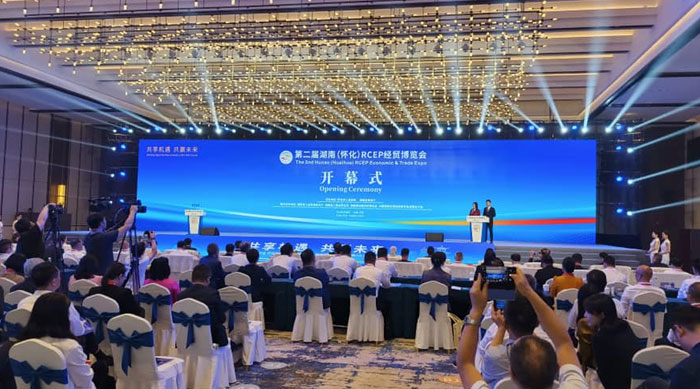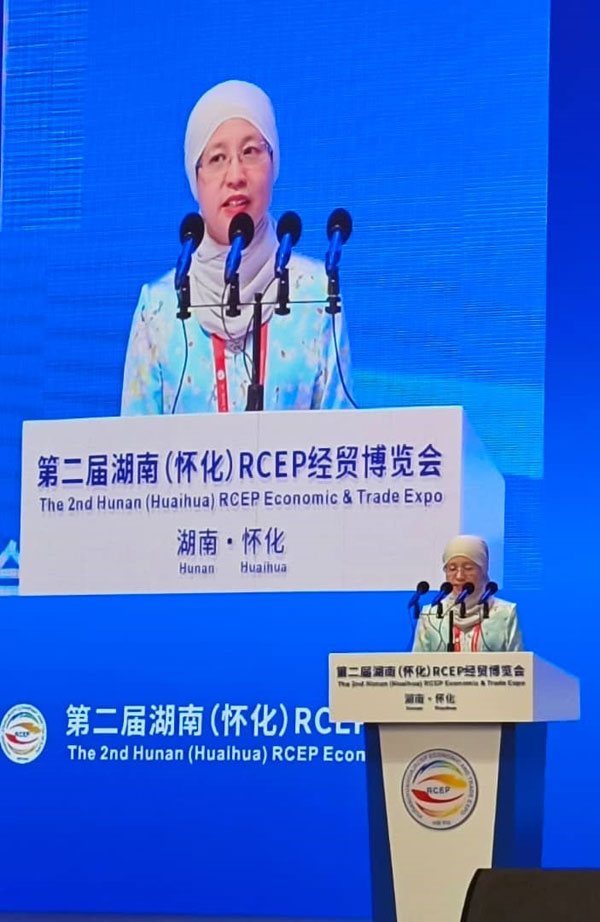The 2nd Hunan (Huaihua) RCEP Economic and Trade Expo officially kicked off on Friday (9th) in Huaihua City.
With the theme of "Sharing Opportunities, Winning the Future," the expo involves 15 member countries of the RCEP (Regional Comprehensive Economic Partnership) and over 20 provinces (regions and cities) from China. It adopts a dual online-offline format to establish an integrated platform for production, supply, and sales for foreign trade.
Huaihua is a member of the "13+2" inter-provincial consultation and cooperation mechanism of the new Western Land-Sea Corridor, and it is Hunan's only freight consolidation center facing ASEAN. Since the Regional Comprehensive Economic Partnership Agreement (RCEP) came into effect in 2022, leveraging its geographical advantage as a convergence point for the Western Land-Sea Corridor and the international land-sea corridor facing the Indian Ocean, Huaihua has become a new platform for opening up the central and western regions to the outside world. The annual import and export volume with other RCEP member countries grew by an average of 87.23% from 2022 to 2024, with export growth topping Hunan for three consecutive years.
Relying on the international dry port, Huaihua has opened seven major international logistics corridors such as China-Laos, China-Vietnam, and China-Myanmar, and 155 international and domestic transport lines, covering 50 countries and regions and 138 ports and sites worldwide. In 2024, Huaihua operated a total of 1,009 train services, among which the ASEAN train services ranked in the top tier in China, with China-Laos train services leading in the central region.
This expo is hosted by the Huaihua Municipal People's Government and the Department of Commerce of Hunan Province.
The opening ceremony was presided over by Huaihua Municipal Party Secretary Xu Zhongjian.

In conjunction with this expo, the Huaihua Municipal Government Information Office, the Huaihua Municipal Government Foreign Affairs Office, and the Huaihua Municipal Bureau of Commerce also organized, and the Hunan Branch of China News Service hosted, the "2025 ASEAN National Mainstream Media Huaihua Tour," inviting over 10 mainstream media from Malaysia, the Philippines, Cambodia, Laos, Myanmar, Thailand, and Indonesia to Huaihua. They conducted interviews with important foreign platforms like the Huaihua International Dry Port, experiencing the vitality and opportunities in economic and trade exchanges between Hunan and ASEAN; exploring Zijiang, Xinhuang, and Xupu areas, capturing the stories of unique regional culture behind natural, human, and economic development.
In the next four days, ASEAN mainstream media will visit the planning exhibition hall, customs supervision area, bag industry park, and port-area enterprises at the Huaihua International Dry Port, exploring how Huaihua builds an open hub with the international dry port as the core carrier, forming an inland open new model of "dry port hub + rule innovation + industry coordination"; they will go to Zijiang County, Xinhuang County, and Xupu County in Huaihua, visiting enterprises related to agricultural product processing, Chinese medicinal materials, and new materials, experiencing the development model of "ASEAN resources—Huaihua manufacturing—RCEP market," achieving the leap from "channel economy" to "industrial economy."

Consul General of Malaysia in Guangzhou, Sulaiman, stated that as a trade-oriented economy, Malaysia will continue to uphold the spirit of open cooperation and promote common development.
She mentioned that free trade agreements are not new to Malaysia, but RCEP, as the largest free trade agreement globally, has unique advantages. RCEP provides member countries with a more transparent and specific rules framework, particularly beneficial for exports such as Malaysian liquefied natural gas, palm oil, rubber, and electronic products.
She added that since 2009, China has been Malaysia’s largest trading partner for 16 consecutive years. In 2024, the total bilateral trade between Malaysia and China reached RMB 838.5 billion (approximately MYR 499.4 billion), accounting for 16.8% of Malaysia’s total foreign trade. Hunan Province plays an important role in Malaysia-China trade.
Sulaiman said that Malaysia attaches great importance to human capital development, and as such, continuously strengthens education, vocational training, and various capacity-building programs. In recent years, exchange and cooperation in the field of training between Malaysia and China have increased, with significant results.
“I am confident that under the RCEP framework, Malaysia and China, adhering to the spirit of win-win cooperation, will surely achieve stable economic development moving forward. However, we must see that cooperation is not just about cold trade numbers, but a bridge for mutual success and shared prosperity.”
